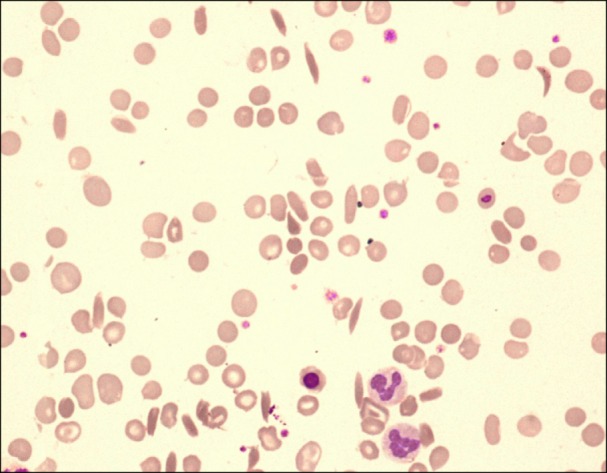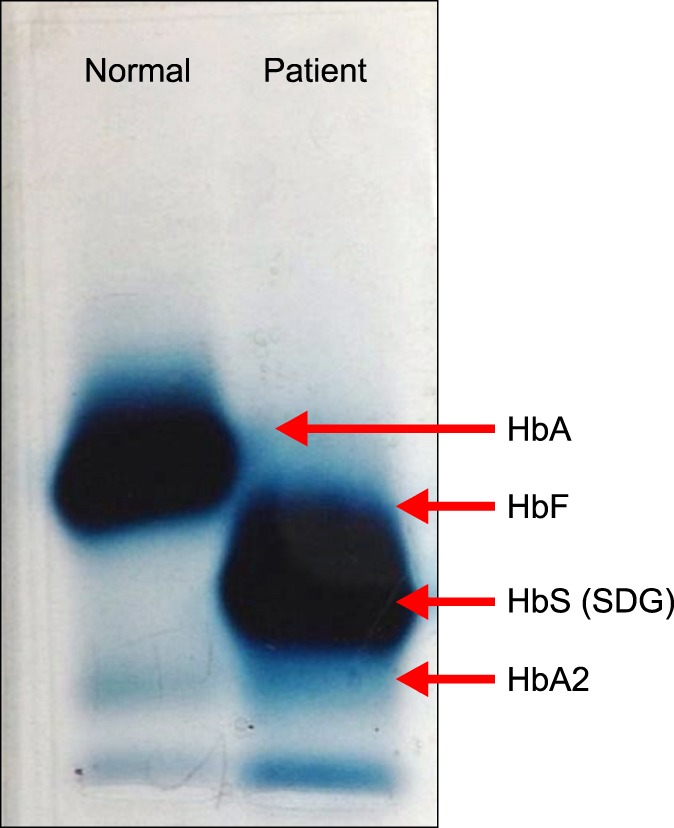TO THE EDITOR: Sickle cell-β thalassemia (HbS-β thalassemia) is a sickling disorder of red blood cells in varying severity, which results from compound heterozygosity for sickle cell trait and β thalassemia trait. In India, the frequency of the βS gene reaches as high as 40%, particularly in the tribal groups, whereas the incidence of the β thalassemia gene is around 3-4% in the general population [1]. Hence, the occurrence of HbS-β thalassemia due to inheritance of both defects is expected to be seen. The prevalence of sickle cell-β thalassemia in India has been reported as <1% in various studies [2]. HbS-β thalassemia was first described by Silvestroni and Bianco [3] in 1944 as a microdrepanocytic disease. Serjeant et al. [4] studied the manifestations of this disease. It is characterized by hepatosplenomegaly, chronic anemia, recurrent attacks of pyogenic infections, avascular necrosis of the bones, and subarachnoid hemorrhage. Hemophilia A is an X-linked recessive disease with a prevalence of 1 in 10,000 male births [5]. It has been estimated that in India 1,300 children with hemophilia are born each year. The chance of both these disorders being present together is extremely rare (1 in 250,000). Here we report an interesting case that not only shows the coinheritance of both these disorders but also the manner in which the presence of one has impacted the manifestation of the other.
A 19-year-old male presented with diffuse abdominal pain. There was no history of vomiting, loose stools, or bleeding. He had a history of being admitted previously with the same complaint and had received a transfusion of three units of red blood cells (RBCs) in the past. On examination, the patient had pallor and icterus, and the spleen was palpable 2 cm below the left costal margin. Blood tests revealed hemoglobin (Hb) of 7.8 g/dL (13-17 g/dL), RBC count 3.15×1012/L (4.5-5.5×1012/L), mean corpuscular volume (MCV) 76.0 fL (83-101 fL), mean corpuscular hemoglobin (MCH) 25.0 pg (27-32 pg), and mean corpuscular hemoglobin concentration (MCHC) 32.0 g/dL (31.5-34.5 g/dL). The white blood cell (WBC) count was 9.8×109/L (4-11×109/L) and the platelet count was 160×109/L (150-450×109/L). The peripheral blood film revealed moderate anisopoikilocytosis with microcytes, target cells, and a few tear drop cells and sickle-shaped cells along with 10 nucleated RBCs (NRBCs)/100 WBCs (Fig. 1). His sickle cell test result was positive. Hb electrophoresis showed a band in the SDG region along with a faint band in the A2 region (Fig. 2). High-performance liquid chromatography (HPLC) showed HbS 81.4%, HbF 5.5%, and HbA2 6.2%. Mutation study analysis was performed using the amplification refractory mutation system-polymerase chain reaction (ARMSPCR) assay, which revealed c.15G>A mutation. The patient was diagnosed as compound heterozygous for HbS-β thalassemia.
After 5 months, the patient presented with excessive bleeding for 6 days following a dental extraction. A coagulation workup was performed. The patient's prothrombin time (PT) and international normalized ratio (INR) were 11.8 seconds (10.4-14.1 sec) and 1.12. The activated partial thromboplastin time (aPTT) was 64.2 seconds (23.0-31.05 sec). Thrombin time was 14.0 seconds (14-19 sec). Factor VIII assay was performed, and the level was found to be <1%. The level for factor IX was 60%. Screening for common thrombophilia markers was performed to rule out the coinheritance of any prothrombotic factor, which could be responsible for the mild phenotype of hemophilia in this case. The investigations revealed protein C 76.1% (normal range, 70-140%), protein S 95.8% (normal range, 70-140%), and antithrombin 126.7% (70-140%). Tests for factor V Leiden and prothrombin G20210A mutations were negative. In the literature, it has been shown that the presence of prothrombotic risk factors can influence the onset of the first symptomatic bleeding in children with previously undiagnosed hemophilia A [6].
Plasma fibrinogen and von Willebrand factor were found to be normal. The patient received local tranexamic acid and 2 units of fresh frozen plasma for 2 days, following which the bleeding stopped. The patient's family also underwent screening. His father has beta thalassemia trait and his mother has sickle cell trait. His sister was found to be a beta thalassemia carrier. The coagulation workup showed no abnormalities in any family member. However, his maternal uncle had expired in an accident. The patient has followed up with us, and experienced one episode of epistaxis and pain crisis in the interim. It was planned to initiate treatment with hydroxyurea owing to the increased episodes of pain crisis.
Coinheritance of β thalassemia and hemophilia A is an uncommon association and coinheritance with sickle β thalassemia is still rarer. HbS-β thalassemia is divided into sickle cell-β+ thalassemia and sickle cell-β° thalassemia, which have, respectively, reduced or no amounts of HbA present. The clinical and hematologic features in HbS-β thalassemia are quite variable. The clinical severity largely depends upon the nature of the β thalassemia mutations. HbS-β thalassemias are classified as HbS-β° thalassemia, having an absence of HbA and with a severe clinical course similar to SS disease, and HbS-β+ thalassemia, usually associated with 20-30% of HbA and with a milder clinical course [7].
Among various mutations, IVS 1-5 (G→C), a severe β+ thalassemia allele, was found to be the commonest, followed by codon 15 (G→A), codon 30 (G→C), and codon 8/9 (+G), which are severe β° thalassemia alleles. In the Indian population, the commonest β thalassemia mutation is seen in 30-80% of heterozygotes, while the majority of the remaining β thalassemia alleles are of the β° type [8].
Joints are vulnerable to hemorrhage in hemophilia because of low levels of thromboplastin in synovial tissue [9]. In addition, in any male child presenting with recurrent episodes of prolonged bleeding, occurring spontaneously or following injury or surgical procedures, hemophilia should be suspected [10]. In our case, the patient presented with bleeding following a dental extraction.
Colah et al. [11] reported an interesting consanguineous family from Western India with a combination of β thalassemia and hemophilia A. Their first child (a male) was diagnosed with β-thalassemia major at 8 months of age and was subsequently transfused every month. At age 2, his gums bled for 5 days after a fall. The coagulation data showed prolonged aPTT with factor VIII assay <1%. The patient was thus diagnosed as suffering from severe hemophilia A with β-thalassemia major.
We found two other reports in the literature in which there was coinheritance of thalassemia with bleeding disorders. In one study, there was a report of two sisters with multiple sclerosis, lamellar ichthyosis, β-thalassemia minor, and a quantitative deficit of factor VIII-von Willebrand complex [12], whereas the second was a report of a female presenting with Wilson's disease with concomitant β thalassemia and factor V deficiency [13].
There is also strong evidence for the presence of a hypercoagulable state in both thalassemia and sickle cell anemia due to platelet activation and the generation of intravascular thrombi [14]. Low plasma levels of protein C, protein S, and antithrombin; elevated plasma levels of thrombin-antithrombin (TAT) complexes, prothrombin fragment 1+2 (F1+2), D-dimer complexes, and circulating antiphospholipid antibodies; platelet activation during vaso-occlusive crises; abnormal external exposure of phosphatidylserine (PS) and adherence of sickle erythrocytes to the vascular endothelium; reduced nitric oxide levels in the presence of hemolytic anemia; and increased tissue factor expression have been detected in sickle cell patients [15]. In our case, although the patient had a factor VIII level of <1%, bleeding complications did not occur owing to the hypercoagulable state attributed to coinheritance of sickle β thalassemia, resulting in a thrombohemorrhagic balance.
To the best of our knowledge, no case describing the combination of sickle cell-β thalassemia with hemophilia A has been reported prior to now. The rarity of the coinheritance of these two disorders and the alterations in presentation, along with the chances of missing the diagnosis of a bleeding disorder with a hypercoagulable state, prompted us to report this case.
References
1. Mukherjee MB, Nadkarni AH, Gorakshakar AC, Ghosh K, Mohanty D, Colah RB. Clinical, hematologic and molecular variability of sickle cell-β thalassemia in western India. Indian J Hum Genet. 2010; 16:154–158. PMID: 21206704.

2. Mohanty D, Colah RB, Gorakshakar AC, et al. Prevalence of β-thalassemia and other haemoglobinopathies in six cities in India: a multicentre study. J Community Genet. 2013; 4:33–42. PMID: 23086467.

3. Silvestroni E, Bianco I. Microdrepanocito-anemia in un soggetto di razza Bianca. Boll A Accad Med Roma. 1944; 70:347.
4. Serjeant GR, Ashcroft MT, Serjeant BE, Milner PF. The clinical features of sickle-cell-thalassaemia in Jamaica. Br J Haematol. 1973; 24:19–30. PMID: 4715134.
5. Mosher DF. Disorders of blood coagulation. In : Wyangaarden JB, Smith LH, Bennett JC, editors. Cecil textbook of medicine. Philadelphia, PA: WB Saunders;1992. p. 1004–1006.
6. Escuriola Ettingshausen C, Halimeh S, Kurnik K, et al. Symptomatic onset of severe hemophilia A in childhood is dependent on the presence of prothrombotic risk factors. Thromb Haemost. 2001; 85:218–220. PMID: 11246535.

7. Weatherall DJ, Clegg JB. The thalassaemia syndromes. 4th ed. Oxford, UK: Blackwell Science Ltd;2001. p. 395.
8. Kulozik AE, Bail S, Kar BC, Serjeant BE, Serjeant GE. Sickle cell-beta+ thalassaemia in Orissa State, India. Br J Haematol. 1991; 77:215–220. PMID: 2004023.
9. Gregg-Smith SJ, Pattison RM, Dodd CA, Giangrande PL, Duthie RB. Septic arthritis in haemophilia. J Bone Joint Surg Br. 1993; 75:368–370. PMID: 8098712.

11. Colah RB, Shetty SD, Surve RR, et al. Prenatal diagnosis in a family at risk for beta-thalassemia and hemophilia A: an uncommon association. Hemoglobin. 2004; 28:343–346. PMID: 15658191.
12. Capra R, Mattioli F, Kalman B, Marcianò N, Berenzi A, Benetti A. Two sisters with multiple sclerosis, lamellar ichthyosis, beta thalassaemia minor and a deficiency of factor VIII. J Neurol. 1993; 240:336–338. PMID: 8336172.

13. Giannini E, Fasoli A, Botta F, Testa R. Wilson's disease with concomitant beta thalassaemia and factor V deficiency. Ital J Gastroenterol Hepatol. 1998; 30:633–635. PMID: 10076789.
14. Eldor A, Rachmilewitz EA. The hypercoagulable state in thalassemia. Blood. 2002; 99:36–43. PMID: 11756150.

15. Ataga KI. Hypercoagulability and thrombotic complications in hemolytic anemias. Haematologica. 2009; 94:1481–1484. PMID: 19880774.





 PDF
PDF ePub
ePub Citation
Citation Print
Print




 XML Download
XML Download